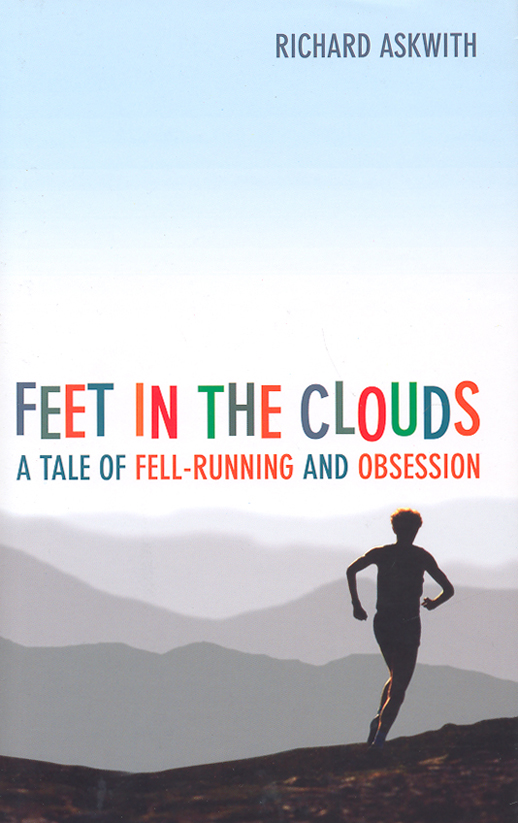
By Richard Askwith (Aurum Press)
Reviewed by Nick Small
It’s New Year’s Day. I’ve had a poor night’s sleep and I’m being pebble-dashed by cold, hard rain, driven on strong crosswinds, as I try to negotiate deep peat bog, a riot of tussocks and sheets of near freezing water on legs rendered uncontrollable by the 300 hundred feet of steep climb I’ve just run. My vision is blurred, I’m struggling for breath and ahead of me is precipitous descent on ground riddled with ankle snapping tree roots that I’m going to hurl myself down despite the protests of the sensible portion of my brain. Why am I doing this? Because Jeff sent me a copy of Richard Askwith’s love missive to fell running, “Feet in the Clouds”, a couple of months ago and it inspired me to take part in this, the annual Giant’s Tooth fell race above Halifax.
The thing is, I’m not alone in being seduced by Askwith’s lyrical take on what seems, at first glance, to be a foolhardy pursuit. The Fell Running Association has seen membership increase from about 6,000 to 7,000 since its publication in 2005 and the book has sold over 50,000 copies, which means it has well and truly “crossed over” as media biz types like to say.
You’d think that this would been seen as cause for celebration by the governing body but the raising of the sport’s profile in faddy lifestyle supplements has brought significant problems. The entry applications for the “glamour” events of the sport have been swelled to such an extent by “things to do before I die” types, that the more competitive championship runners have found themselves squeezed. Fell racing is unusual as a sport in that it depends upon the good will of land owners for access to its routes and, of course, there are environmental considerations where hundreds of runners might be arriving in cars, parking and then trampling all over areas of natural beauty and fragile eco-systems. Necessarily, numbers have to be limited. Still, this is only an issue for those organising races and administering the sport.
So, why has this book connected with so many people? Well, it’s tremendously well written for a start. Richard Askwith was associate editor of the Independent, so can turn a neat phrase. The book is also constructed in quite an unusual way, chronicling the fell racing calendar whilst recounting the rather gruelling personal story of the author’s attempts to complete the Bob Graham Round, a rather arbitrary collection of Lakeland peaks to be tackled in a 24 hour period. Along the way, the romance of the sport is explained, largely in the context of its people, from the folk who turn up to stand atop mountains, marshalling events to the racing heroes of the sport.
The heroes are something else. Ordinary working people from unglamorous backgrounds who have managed near superhuman feats for scant reward other than the process itself: Joss Naylor, the Wasdale farmer whose legendary exploits are well enough documented; Kenny Stuart the Cumbrian gardener whose fleet footed conquests of Ben Nevis (1hr 25m34s….think about it) and Snowden (1hr2m29s) in the mid 80s are records which still stand today and Ian Holmes, a Keighley jacuzzi fitter and multiple British Champion who is still competitive at the elite end of the sport in his 40s. There are tales of derring-do, skulduggery and intrigue going back over a century to the days when the runners were shepherds with wealthy patrons who “owned” and gambled upon them as though they were race horses. Perhaps the most fascinating chapter in the book deals with the bizarre and destructive squabble that took place between the professional and amateur branches of fell racing right up to the early 1990s.
Above all of this though, the book connects because it taps into the zeitgeist: the same one that draws people to wild swimming, mountain biking, kite surfing, wilderness craft, fishing and all those other expressions of our desire to seek “otherness”; getting away from the job, the city, the mortgage and all the comforts that separate us from wild nature. Experiencing the beauty and the beastliness of the universe on our own, with no safety net other than that which our wits allow us; testing our minds and bodies against the elements in ways that are as primal as we can muster, seeking to be reminded “what it’s all about”. It’s very much in the same ball park as “The Art of Camping” which I reviewed here last year.
I would recommend “Feet in the Clouds” but with a caution. It may well convince you, as it did me, to go and run a fell race. If it does, just remember that you can enjoy running on wild hills recreationally without entering high profile races that are already over-subscribed. Running for fun is just as liberating and, if you do feel the need to race, there will probably be events in your local area that would be much more appreciative of your support.
The Giant’s Tooth race is one such low-key affair. As I crossed the line in a heap and slumped against the nearest wall, I vowed “never, ever, again”. Thirty minutes and a pint of Taylor’s Golden Best in convivial company later, I was planning next year’s race, convincing myself that I could do it three and a half minutes faster.
Read “Feet in the Clouds” and you’ll realise that this is entirely normal.